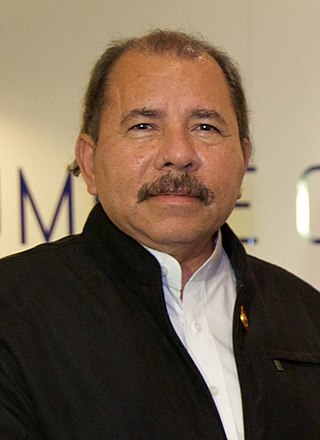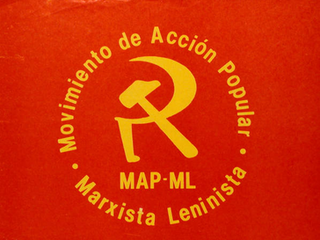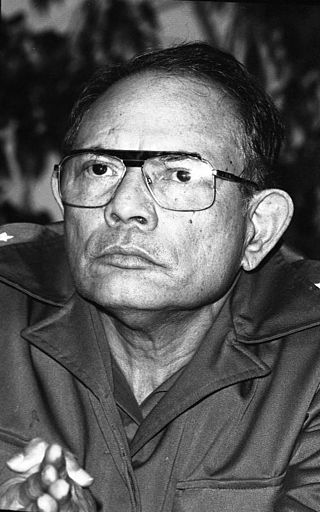
José Daniel Ortega Saavedra is a Nicaraguan revolutionary and politician serving as President of Nicaragua since 2007. Previously he was leader of Nicaragua from 1979 to 1990, first as coordinator of the Junta of National Reconstruction (1979–1985) and then as President of Nicaragua (1985–1990).
Nicaragua is a nation in Central America. It is located about midway between Mexico and Colombia, bordered by Honduras to the north and Costa Rica to the south. Nicaragua ranges from the Caribbean Sea on the nation's east coast, and the Pacific Ocean bordering the west. Nicaragua also possesses a series of islands and cays located in the Caribbean Sea.

The Sandinista National Liberation Front is a socialist political party in Nicaragua. Its members are called Sandinistas in both English and Spanish. The party is named after Augusto César Sandino, who led the Nicaraguan resistance against the United States occupation of Nicaragua in the 1930s.

The Somoza family is a former political family that ruled Nicaragua for forty-three years from 1936 to 1979. Their family dictatorship was founded by Anastasio Somoza García and was continued by his two sons Luis Somoza Debayle and Anastasio Somoza Debayle. Anastasio Somoza García was the President of Nicaragua from 1937 until 1956. He was succeeded by his eldest son, Luis Somoza Debayle, who held the presidency from 1957 to 1963. The youngest Somoza son, Anastasio Somoza Debayle, held two presidential terms: 1967-1972 and 1974-1979. Although the Somozas did not hold the presidency for the full forty-three years, they continued to rule through puppet presidents and their control of the National Guard.

The Nicaraguan Revolution encompassed the rising opposition to the Somoza dictatorship in the 1960s and 1970s, the campaign led by the Sandinista National Liberation Front (FSLN) to oust the dictatorship in 1978–79, the subsequent efforts of the FSLN to govern Nicaragua from 1979 to 1990, and the Contra War, which was waged between the FSLN-led government of Nicaragua and the United States–backed Contras from 1981 to 1990. The revolution marked a significant period in the history of Nicaragua and revealed the country as one of the major proxy war battlegrounds of the Cold War, attracting much international attention.

Herty Lewites Rodríguez was a Nicaraguan politician. He was Mayor of Managua and a candidate for president in the 2006 Nicaraguan general election when he died suddenly.

The Republic of Nicaragua elects on the national level a head of state – the president – and a unicameral legislature. The President of Nicaragua and his or her vice-president are elected on one ballot for a five-year term by the people.

Popular Action Movement - Marxist–Leninist is a Hoxhaist communist party in Nicaragua that surged out of a split from the Sandinista National Liberation Front (FSLN) in the early 1970s. Since 1985 it is officially named the Marxist–Leninist Party of Nicaragua, but the original name MAP-ML is far more known and has been used when participating in elections.

The Junta of National Reconstruction was the provisional government of Nicaragua from the fall of the Somoza dictatorship in July 1979 until January 1985, with the election of Sandinista National Liberation Front’s Daniel Ortega as president.
Sandinista ideology or Sandinismo is a series of political and economic philosophies instituted by the Nicaraguan Sandinista National Liberation Front throughout the late twentieth century. The ideology and movement acquired its name, image and most crucially, its military style from Augusto César Sandino, a Nicaraguan revolutionary leader who waged a guerrilla war against the United States Marines and the conservative Somoza National Guards in the early twentieth century. Despite using the Sandino name, the principals of modern Sandinista ideology were mainly developed by Carlos Fonseca, inspired by the leaders of the Cuban Revolution in the 1950s, sought to inspire socialist populism among Nicaragua's peasant population. One of these main philosophies involved the institution of an educational system that would "free" the population from the perceived historical fallacies spouted by the ruling Somoza family. By awakening political thought among the people, proponents of Sandinista ideology believed that human resources would be available to not only execute a guerrilla war against the Somoza regime but also build a society resistant to economic and military intervention imposed by foreign entities.

General elections were held in Nicaragua on 5 November 2006. The country's voters went to the polls to elect a new President of the Republic and 90 members of the National Assembly. Daniel Ortega (FSLN) won the election with 37.99% of the vote, Eduardo Montealegre (ALN) trailing with 28.30%, José Rizo (PLC) with 27.1%, Edmundo Jarquín (MRS) with 6.29%, and Edén Pastora (AC) with 0.29%.

Tomás Borge Martínez, often spelled as Thomas Borge in American newspapers) was a cofounder of the Sandinista National Liberation Front in Nicaragua and was Interior Minister of Nicaragua during one of the administrations of Daniel Ortega. He was also a renowned statesman, writer, and politician. Tomás Borge also held the titles of "Vice-Secretary and President of the FSLN", member of the Nicaraguan Parliament and National Congress, and Ambassador to Peru. Considered a hardliner, he led the "prolonged people's war" tendency within the FSLN until his death.

The Nicaraguan Liberal Alliance is a political coalition in Nicaragua. It was started in 2005 by Eduardo Montealegre and other members of the Constitutional Liberal Party who opposed former President of the country Arnoldo Alemán's continued control of the PLC even after he had been found guilty of misuse of public funds, and was sentenced to 20 years in prison. Montealegre also opposed the political alliance, commonly referred to as 'El Pacto', between Alemán as head of the PLC and Daniel Ortega, head of the Sandinist National Liberation Front.
General elections were held in Nicaragua on 25 February 1990 to elect the President and the members of the National Assembly. The result was a victory for the National Opposition Union (UNO), whose presidential candidate Violeta Chamorro surprisingly defeated incumbent president Daniel Ortega of the Sandinista National Liberation Front (FSLN). This led to a historic peaceful and democratic transfer of power in Nicaragua.
In 1979, the Sandinista National Liberation Front (FSLN) overthrew Anastasio Somoza Debayle, ending the Somoza dynasty, and established a revolutionary government in Nicaragua. Following their seizure of power, the Sandinistas ruled the country first as part of a Junta of National Reconstruction. Following the resignation of centrist members from this Junta, the FSLN took exclusive power in March 1981.

General elections were held in Nicaragua on 6 November 2011. The incumbent president Daniel Ortega, won a third term in this election, with a landslide victory.
Convergencia Nacional or the National Convergence alliance was a coalition of a number of Nicaraguan political organizations, formed in support of Daniel Ortega's bid in the presidential election of 2001. Despite losing the presidential election, the FSLN-led alliance made steady gains in the 2004 municipal elections, and Ortega was elected president in 2006. The alliance included Ortega's FSLN, Nationalist Liberal Party, Popular Conservative Alliance, Marxist–Leninist Popular Action Movement, Nicaraguan Christian Democratic Union, as well as the Unidad Social Cristiana PUSC and dissident minority factions of the Sandinista Renovation Movement, Nicaraguan Liberal Alliance, Constitutionalist Liberal Party, Nicaraguan Resistance Party and YATAMA. Majority factions of the latter 6 organizations have joined the anti-Ortega coalition Alianza PLC founded in 2008.

General elections were held in Nicaragua on 6 November 2016 to elect the President, the National Assembly and members of the Central American Parliament. Incumbent President Daniel Ortega of the Sandinista National Liberation Front (FSLN) was re-elected for a third consecutive term amid charges he and the FSLN used their control of state resources to bypass constitutional term limits and hamstring political rivals. The FSLN benefited from strong economic growth and relatively low levels of crime compared to neighbouring countries.

Luis F. Carrión Cruz is Nicaraguan politician. He is a former guerilla and one of the nine commandantes of the Sandinista (FSLN) National Directorate that overthrew the Somoza regime in 1979. Born to a wealthy, politically-connected family, he began college in the United States but returned to Nicaragua, first joining a radical Catholic group then the FSLN. He led the Carlos Roberto Huembes Eastern Front in Chontales during the final offensive of the revolution. He was a government minister and member of the FSLN National Directorate until 1995 when he split with party and became a cofounder of the Sandinista Renovation Movement (MRS).

Moisés Hassan Morales is a Nicaraguan politician. He was one of five members of the Junta of National Reconstruction that ruled the country from 1979 to 1984, following the fall of the Somozas regime.















